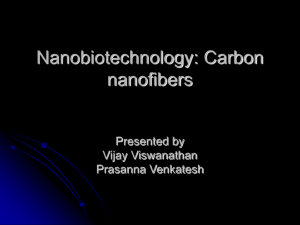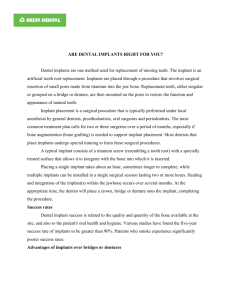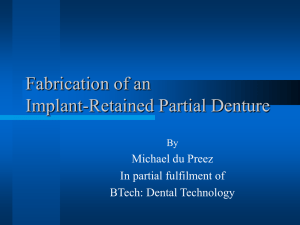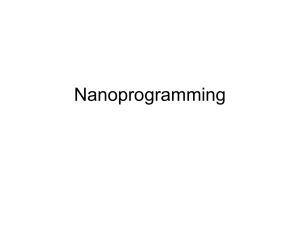On Nano Size Structures For Enhanced Early Bone Formation Luiz
advertisement
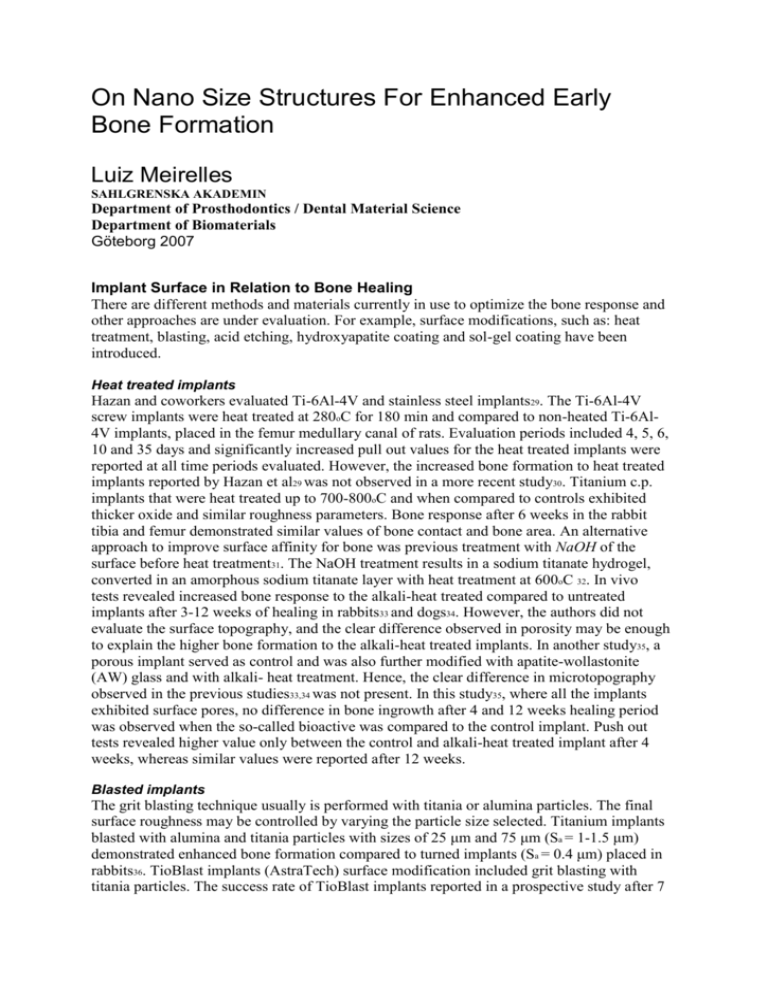
On Nano Size Structures For Enhanced Early Bone Formation Luiz Meirelles SAHLGRENSKA AKADEMIN Department of Prosthodontics / Dental Material Science Department of Biomaterials Göteborg 2007 Implant Surface in Relation to Bone Healing There are different methods and materials currently in use to optimize the bone response and other approaches are under evaluation. For example, surface modifications, such as: heat treatment, blasting, acid etching, hydroxyapatite coating and sol-gel coating have been introduced. Heat treated implants Hazan and coworkers evaluated Ti-6Al-4V and stainless steel implants29. The Ti-6Al-4V screw implants were heat treated at 280oC for 180 min and compared to non-heated Ti-6Al4V implants, placed in the femur medullary canal of rats. Evaluation periods included 4, 5, 6, 10 and 35 days and significantly increased pull out values for the heat treated implants were reported at all time periods evaluated. However, the increased bone formation to heat treated implants reported by Hazan et al29 was not observed in a more recent study30. Titanium c.p. implants that were heat treated up to 700-800oC and when compared to controls exhibited thicker oxide and similar roughness parameters. Bone response after 6 weeks in the rabbit tibia and femur demonstrated similar values of bone contact and bone area. An alternative approach to improve surface affinity for bone was previous treatment with NaOH of the surface before heat treatment31. The NaOH treatment results in a sodium titanate hydrogel, converted in an amorphous sodium titanate layer with heat treatment at 600oC 32. In vivo tests revealed increased bone response to the alkali-heat treated compared to untreated implants after 3-12 weeks of healing in rabbits33 and dogs34. However, the authors did not evaluate the surface topography, and the clear difference observed in porosity may be enough to explain the higher bone formation to the alkali-heat treated implants. In another study35, a porous implant served as control and was also further modified with apatite-wollastonite (AW) glass and with alkali- heat treatment. Hence, the clear difference in microtopography observed in the previous studies33,34 was not present. In this study35, where all the implants exhibited surface pores, no difference in bone ingrowth after 4 and 12 weeks healing period was observed when the so-called bioactive was compared to the control implant. Push out tests revealed higher value only between the control and alkali-heat treated implant after 4 weeks, whereas similar values were reported after 12 weeks. Blasted implants The grit blasting technique usually is performed with titania or alumina particles. The final surface roughness may be controlled by varying the particle size selected. Titanium implants blasted with alumina and titania particles with sizes of 25 μm and 75 μm (Sa = 1-1.5 μm) demonstrated enhanced bone formation compared to turned implants (Sa = 0.4 μm) placed in rabbits36. TioBlast implants (AstraTech) surface modification included grit blasting with titania particles. The success rate of TioBlast implants reported in a prospective study after 7 years was 96.9% with the same survival rate at 10 years. Compared to turned implants, TioBlast implants demonstrated lower bone loss and higher overall success rates37,38. Grit blasting represented the first clinically applied surface modification of titanium implants; the technique has then been further modified with acid etching, such as: SLA (Straumann) and Osseospeed (AstraTech). Acid Etched implants Acid etching of titanium removes the oxide layer and parts of the underlying material, even if the surface oxide immediately reforms under normal conditions. The extent of material removed depends on the acid concentration, temperature and treatment time. The most commonly used solutions for acid etching of titanium includes: a mixture of HNO3 and HF or a mixture of HCl and H2SO4 39. Fluoride treatment has been investigated in the field of biomaterials field due to the benefits of this element in bone physiology. An in vitro analysis of fluoride modified implants was performed with human mesenchymal cells. No difference in cell attachment40,41 was detected between the fluoride modified and control (grit-blasted) implants. In addition, decreased cell proliferation was observed after 7 days on the fluoride modified compared to control (grit-blasted) implants41. The results of osteoblast differentiation showed increased expression of Cbfa140,42, osterix40 and bone sialoprotein41 to fluoridated implants. An in vivo evaluation was performed to test the potentially enhanced bone response to fluoride modified implants. Ellingsen (1995)43 used an aqueous solution with up to 4% of NaF for etching titanium c.p. coined-shape implants. After 4 and 8 weeks the push out test revealed an improved retention for the NaF treated implant compared to control (untreated) implants. Moreover, improved bone formation was observed on screw shaped implants treated with diluted HF solution44. Analyses were performed after 1 and 3 months. Fluoride modified implants exhibited increased bone contact and bone area values at both periods evaluated compared to the control implants. Removal torque evaluations showed higher values for the fluoride implants after a 3-month healing period, but no difference at 1 month. Enhanced bone formation was reported at an earlier healing period of 21 days41. In this study41, implants were placed in the rat tibia, and showed increased bone contact values for the fluoride modified implants compared to the control (untreated) implants. Hydroxyapatite coated implants Hydroxyapatite is one of the materials that may form a direct and strong binding between the implant and bone tissue45,46, named as bioactive according to Osborn & Newesely28 classification. This property of hydroxyapatite, Ca10(PO4)6(OH)2, is related to a sequence of events that results in precipitation of a CaP rich layer on the implant material through a solidsolution ion exchange on the bone-implant interface47,48. This reaction will occur simultaneously with biomolecules incorporation and cell recruitment. The CaP incorporated layer will gradually be developed, via octacalcium phosphate49, in a biologically equivalent hydroxyapatite46,50 that will be incorporated in the developing bone46,51,52. Synthetic hydroxyapatite has also been widely investigated for biomaterials applications due to the similar chemical composition when compared to the mineral (inorganic) matrix of bone, which is generally referred to as hydroxyapatite. Different elements, such as: F and Si, may be introduced in the synthetic apatite. The presence of different elements in the apatite crystal is of great importance for the surface kinetics of the synthetic material that ultimately is related to bone response. The dissolution rate of the material depends on the particle size, porosity, specific surface area and crystallinity. For example, when comparing to hydroxyapatite; the carbonate apatite is less stable and the fluoride apatite is more stable53,54. The decreased dissolution rate of carbonate apatite has been attributed to the simultaneous increase in particle size, evaluated by TEM55. It was observed that a higher content of carbonate was associated to an increased particle size. Thus, increased dissolution rate may be related not only to the chemical composition, but also be associated to the difference in particle size. Depending on the fabrication technique, hydroxyapatite may show a similar crystal structure as the mineral phase of bone. The hydroxyapatite properties known already by early 1980s resulted in an intense investigation for the potential application of the material. HA bulk material was first used for alveolar ridge augmentation56,57 and craniofacial reconstructive surgery58. Further evaluation of bulk HA as a load-bearing implant59,60 failed in long-term and fractured due to fatigue failure of the ceramic material. The low shear strength of bulk HA required a different approach, where the material was applied as coating on metals. Initially promising results in the late 1980s were reported from different groups in animal experiments61,62. The coat was based on the plasma spraying method63. HA coatings techniques Important factors for the behavior of the HA coatings include: chemical composition, Ca/P ratio, crystallinity, microstructure, adhesive strength, thickness and presence of trace elements64. Different methods have been described for applying hydroxyapatite coatings onto metals and different material properties may result from each method. Plasma-spraying is the most important commercially used technique for coating metals, especially titanium. In a so-called plasma gun, an electric arc current of high energy is struck between a cathode and an anode. An inert gas is directed through the space between these electrodes, and the arc current ionizes the gas and a plasma is formed65. The rapidly moving particles present in the plasma are accelerated towards the cathode and anode and then collide with others atoms. The high speed flame with melted particles is directed to the material surface and the ceramic powder is deposited. Initial reports suggested that a chemical bond would occur between the ceramic deposited and the titanium oxides66. However this chemical bond was never proven to exist. Plasma spraying technique results in a coating thickness of minimally 40-50 μm. Furthermore, this technique lacks in stability of the deposited ceramic and an amorphous phase is a common finding. It may also be difficult to have a homogenous coating layer on samples with complex design. In vivo results showed a faster bone integration in short-term evaluations, however longer evaluation periods failed to maintain the increased bone response values67-70. Moreover, some complications have been reported on load bearing implants placed in humans due to de-attachment of the ceramic coating from the bulk metal71-74. Spark anodizing is a method based on the principle of anodic oxidation of the metal, a well known method to increase oxide thickness of the metal. In contrast to the anodizing process where the voltage is kept below the dielectric breakdown, spark anodizing is carried out at voltages above the breakdown limit39. The thickness of the oxide produced may vary from a few up to 20 μm. If calcium and phosphate are added to the solution, the oxide formed will incorporate such elements, but not as hydroxyapatite75. Hydrothermal post-treatment has proven effective in converting the non crystalline calcium phosphate in the oxide into crystalline hydroxyapatite76. An adhesion strength of 38-40 MPa was achieved with a low electrolyte concentration that lead to an incomplete coverage of the implant by HA crystals and lower bone response, when compared to implants with full HA coverage76,77. Even when compared to turned implants, the spark anodized with HA crystals failed to show increased bone formation78. So far, no implants have been placed in humans with this modification. HA thin coatings techniques (< 10 μm) Pulsed laser deposition is a method with well controlled thickness of the coating. The number of laser pulses determined the desired film thickness, deposited at a rate of approximately 0.02 nm/laser shot. The crystalline phases of CaP formed, Ca/P ratio and coating adhesion are dependent on the temperature and gas content in the vacuum chamber. Interestingly, the coating thickness used for in vitro an in vivo tests was 2,0 μm79,80, a thickness that may lead to the undesirable de-attachment. So far, no implants have been placed in humans with this modification. Sputter deposition is a process that ejects atoms or molecules of a material by bombardment of high energy ions. There are several sputter techniques and a common drawback inherent in all these methods is that the deposition rate is very low and the process itself is very slow81. The deposition rate is improved by using a magnetically enhanced variant of diode sputtering, so-called radiofrequency magnetron sputtering82. In vivo evaluation at short- and long- term periods revealed more bone contact compared to amorphous CaP and turned implants83,84. However, no implants have been clinically documented with this surface modification. The Sol-gel method has been successfully used to deposit hydroxyapatite thin films on titanium samples with different designs, such as discs, cylinders and screws85,86. The thickness may vary from 1 to 10 μm. Coating thickness can be controlled during the different stages of the sol-gel process or by simply adding different number of layers on the substrate. The low bond strength observed on sol-gel derived HA layers 86 may be improved by mixing TiO2 sol with HA sol, producing a HA-TiO2 composite sols87. The sol-gel method may produce different ceramics of interest for osseointegrated implants, different from HA, as will be discussed in the next section. Sol-Gel coated implants The sol-gel method represents a simple and low cost procedure with homogenous chemical composition onto substrates with large dimensions and complex design. Sol-gel processing of inorganic ceramic and glass materials started at the mid 1800s88, when it was reported that hydrolysis of tetraethyl orthosilicate formed SiO2. However, at that time, extremely long drying periods (1 year or more) were necessary and consequently there was little technological interest. The development of new evaluation techniques from the 1950s, for example: nuclear magnetic resonance and X-ray photoelectron spectroscopy enabled the investigation of each step of the sol-gel process on the nanometer scale. The better understanding and control of each step of the sol-gel process allowed a remarkable decrease in the drying step without damage to the coating89. The sol-gel method has attracted great attention in the field of biomaterials since the final product may include hydroxyapatite and titania, two of the most common materials used for osseointegrated implants. Sol-gel titania films may be prepared using a dip coating90,91 or spin coating92 process. Titania bonding strengths of the films are related to the surface pre-treatment, firing atmosphere, and surface topography93. Moreover, the particle size and particle aggregation can be modulated by the aging time of the sol; that may produce different coating thickness, ranging from 210 to 380 nm94. In addition, the number of layers applied onto the sample affects the surface topography. A more narrow peak distance distribution was demonstrated with 5 layers compared to 1 layer95. In vivo bone tissue evaluations of surfaces modified using the sol-gel method have been mainly performed on CaP or glass materials. Bone formation was in close contact with the material and no adverse reaction was observed96,97. However, the behavior of sol-gel modifications of loaded osseointegrated implants in the long term remains unknown. Topography The modifications currently available for osseointegrated implants, and generally in use, are a variation of physical and/or chemical methods. Most often a chemical modification also results in different surface chemistry, surface energy and surface charge. In addition, some modifications, like HA coated implants, possess surface properties that distinguish them from turned implants, besides the obvious difference in surface chemistry and microtopography. In this section, topographical modification experiments performed by several authors were considered, even when a chemical method was used. However, the potential variables besides the difference in surface topography highlighted by the authors should be kept in mind. Implant surface topography may be divided in: macro, micro and nano level of resolution, as represented by Figure 2. In vitro Surface microtopography has been reported to influence cell adhesion, morphology, proliferation and differentiation. Bowers et al98 investigated osteoblast attachment on c.p. titanium discs. Higher cell attachment was observed on the sand blasted discs after 30-, 60and 120 minutes compared to smoother surfaces, that were polished and acid etched. Similar results were reported by Keller et al99. Osteoblast like cells attachment was evaluated on c.p. titanium discs with different surface roughness. A tendency for higher osteoblast like cell attachment for the rougher (sandblasted) surfaces compared to smooth (polished) surfaces after 15-, 30- and 60 minutes was observed. After 120 minutes, there was a significant increase of cell attachment on the rougher sandblasted (Ra=0.9 μm) compared to smoother surfaces polished with 600 grit SiC paper (Ra=0.2 μm) and the smoothest one polished with 1μm diamond paste (Ra=0.04 μm). Cell attachment does not represent the entire cell activity on implants. Cell activity on surfaces may also be demonstrated by the differences in cell proliferation and gene expression. Boyan et al100 evaluated osteoblast like cells on turned (Ra=0.6 μm), grit-blasted/acid etched (Ra=4.0 μm) and plasma sprayed (Ra=5.2 μm) surfaces. Cell morphology was similar after 14 days on the different surfaces. In addition, calcium and phosphorous content did not vary with the surface roughness, whereas cell proliferation decreased as the surface roughness increased. In contrast, alkaline phosphatase activity was increased with increasing roughness. Masaki et al40 evaluated the gene expression of bone ECM proteins and transcription factors of human mesenchymal cells on: 1. TiO2 grit blasted (Sa=1.1μm) surfaces, 2. (1) + acid etched in dilute HF solution (Sa=0.9 μm) surfaces, 3. grit blasted Al2O3 + acid etched in H2SO4/HCl and 4. (3) prepared under N2 atmosphere and stored in NaCl. The Sa values of the surfaces 1and 2 were reported from a previous study44 and the Sa values of the surfaces 3 and 4 were not reported. After 72 h, no difference in osteocalcin, bone sialoprotein II and collagen type I expression were detected among the investigated surfaces. In contrast, Cbfa1 and osterix expression was higher on surfaces 1 and 2; and ALP gene expression was higher on surface 4, compared to the other surfaces. In vivo Several reports evaluated bone formation to implants with different surface roughness, measured as bone contact to the implant surface and/or biomechanical tests of the boneimplant interface. Generally, rougher implants show enhanced bone formation compared to smoother implants101-104. Titanium implants surface microtopography was firstly described with 3D roughness parameters in 1992105. Later, blasted implants with different 3D roughness parameters were evaluated in a series of studies106-109 and an optimal surface range of roughness was suggested for Sa values between 1-1.5 μm36 . The continued increase of surface roughness above this range was not correlated with correspondent increase of bone response, on the contrary, the opposite was the case. Today, most currently available dental implants exhibit a moderately rough implant surface, with 3D surface roughness values within the optimal range as suggested by Wennerberg & Albrektsson110. Nano topography In this thesis nano topography will be separated in two sub headings: Nano Roughness and Nano Features, which could have been applied to microtopography (previous section) as well. However, the literature concerning surface micro topography generally refers to surface roughness, not referring to individual features with micro dimensions present at the material surface. The nano topography literature commonly refers to both nano roughness and to specifically designed nano features added on the material surface, so called nanofabricated materials. It is important to understand that the overall surface roughness parameters of the sample will be modified when features are added on the surface i.e., by adding nano features, the surface roughness will be modified as well. Moreover, the nano rough materials may also possess nano features; however, the modification used to produce the so-called nano rough materials did not intentionally produce such nano features and, from the surface roughness parameters described is not possible to evaluate the dimension of each individual feature at the surface. In contrast, nano fabricated features have well defined dimensions that aim to modulate cell activity. Specific cell response, such as: attachment, migration, proliferation and differentiation can be obtained guided by the features present at the surface. Nano Roughness In vitro Webster et al111 evaluated osteoblast adhesion on alumina and titania discs prepared by compacting powders with different particles size onto the surface. The discs were sintered at different temperatures to obtain different nano roughness parameters of alumina and titania materials. Significantly increased osteoblast adhesion was observed on alumina discs with increased root mean square deviation (Sq) of 20 nm compared to 17 nm and larger surface area of 1.73 compared to 1.15 μm2, respectively. Furthermore, the titania discs revealed increased osteoblast adhesion to discs with increased surface roughness (32 and 12 nm, respectively) and larger surface area (1.45 and 1.07 μm2, respectively). In addition, discs prepared with an identical method, but the powders consisting of Ti, Ti6Al4 and CoCrMo were tested. As previously reported for alumina and titania discs, increased osteoblast adhesion was found in the discs from the three groups with increased Sq values112. Webster et al113 investigated osteoblast adhesion and type and concentration of different proteins adsorbed on the surface. The materials included were: alumina, titania and HA, with different nano roughness. Pore diameter and porosity (%) were also calculated. As previously reported, the osteoblast adhesion was greater on the discs that exhibited increased nano roughness, independent of the different surface chemistry. Surface porosity was higher and pore diameter decreased on the discs with increased nano roughness. Protein adsorption revealed greater amount of vitronectin associated to the increased osteoblast adhesion on the nano rougher implants. The osteoblast proliferation and ALP synthesis on these surfaces was evaluated on another study from the same group114. Osteoblast proliferation increased in all tested discs (alumina, titania and HA) with increased nano roughness after 3 and 5 days. In addition, ALP synthesis was higher after 21 and 28 days on the discs with increased nano roughness values. Oliveira & Nanci115 cultured new bone rat calvaria cells on titanium discs etched with H2SO4 and H2O2. The acid etched surface revealed nano pits, whereas the control (turned) surfaces failed to show such features, although the surface roughness was not numerically evaluated. The results indicated an overexpression of OPN and BSP both intra- and extracellulary. In addition, a higher proportion of cells was observed with peripheral cytoplasmic distribution of OPN as early as 6h. Nano Features The literature cited in the following section will include nano feature modifications that exhibit at least one dimension below the 100 nm limit. The first commonly investigated design116,117, with controlled dimensions on the surface, was the parallel groove and ridge arrangement at the micro level of resolution. Cell orientation was related to the groove orientation, described as the contact guidance phenomenon. The methods currently in use enable the fabrication of features with well controlled dimensions within the nanometer level. However, the groove and ridge arrangements are not in use for metal implants with complex designs, even if important findings on cell activity have emerged from these investigations. Wojciak-Stothard et al118 investigated murine macrophages on flat and nano grooved surfaces with different depths. Fifteen minutes after plating, most cells remained rounded on the plain substrata compared to well spread cells observed on the nano grooved substrata, which indicates cell activation. Moreover, cell adhesion increased gradually from the plain substrata to the shallow (30 nm) grooved substrata with higher values observed on the deepest (282 nm) grooved substrata. Similar results were found for cell orientation; the deeper the grooves the more orientated the cells. Readers interested in a more detailed explanation of the importance of groove and ridge dimensions on cell activity and orientation are directed to review papers in the field (Curtis & Wilkinson119; Flemming et al120). Another approach to optimize cell activity with nano features include the so-called islands121,122 or hemispherical pillars123,124, achieved by polymer demixing processes or colloidal lithography. Dalby et al121 compared fibroblast activity on flat surfaces and surfaces with 13 nm high islands of a diameter of 263 nm. After 3 days, increased fibroblast spreading, more focal contacts associated to vinculin, upregulation of genes involved with cell signaling and collagen precursors were observed on the surfaces with nano islands compared to the flat surfaces. In another study122, endothelial cell activity was tested on surfaces with islands with heights of 13-, 35- and 95 nm. Similar to fibroblasts 121, endothelial cells on the surfaces with 13nm islands revealed the largest cell areas (longer and wider axes) and a well defined cytoskeleton, compared to the flat and to the 35- and 95 nm island surfaces. Contrary to the increased activity of the fibroblast and endothelial cells, surfaces with similar features (18-, 35 and 95 nm height islands) did not influence rat calvaria bone cells125. In a recent paper, Dalby et al126 compared cell activity on surfaces with different nano features, including 35- and 45 nm height islands with a diameter of 2.2 μm and 1.7 μm, respectively. Features with column shape with 10 nm height and 144 diameter were added on the flat (control) substrata. The human bone marrow cells showed an increased cell spreading on all the three groups with nano features compared to flat substrata, with cells extending filopodia towards the nano features. It was also demonstrated a well defined cytoskeleton, enhanced expression of stress fibers with clear focal contacts, and increased expression of osteocalcin and osteopontin on the substrata with nano features. The most used material at present for nano fabrication is silicon or polystyrene (tissue culture plastic). These materials are cheap and very easy to work with due to several chemical reactants available. However, silicon and polystyrene do not have the mechanical properties required to load bearing osseointegrated implants. Recently, a modification with defined nano size crystals was implemented on titanium samples, through the sol-gel route. Zhu et al127 prepared nano HA crystals of 15-50 nm in length and coated turned and anodized titanium plates. Mouse pre osteoblast cells had decreased adhesion after 15 min on the nano HA coated surface and similar values after 30 min compared to the control (uncoated) implants. Nano HA showed well developed filopodia and lamellipodia compared to the control implants; that demonstrated a greater number of focal contacts. The size of the nano crystals was not evaluated on the surface. Therefore, the size of the features present at the surface is unknown. Sato et al128 reported the dimensions of the nano HA crystal of 40-100 nm in length and diameter of 20-30 nm. However, SEM and laser particle size analyses revealed crystal agglomerations and broad size distribution, resulting in features up to 10 μm at the surface. Thus, the use of precursor materials with nano sizes may not ensure the equivalent size on the final surface. There is clear evidence from numerous in vitro studies that cell activity can be modulated by nano size structures of different dimensions and distribution at the surface. However, there is no evidence of modulation of in vivo bone tissue response to implants due to nano size surface structures alone.

